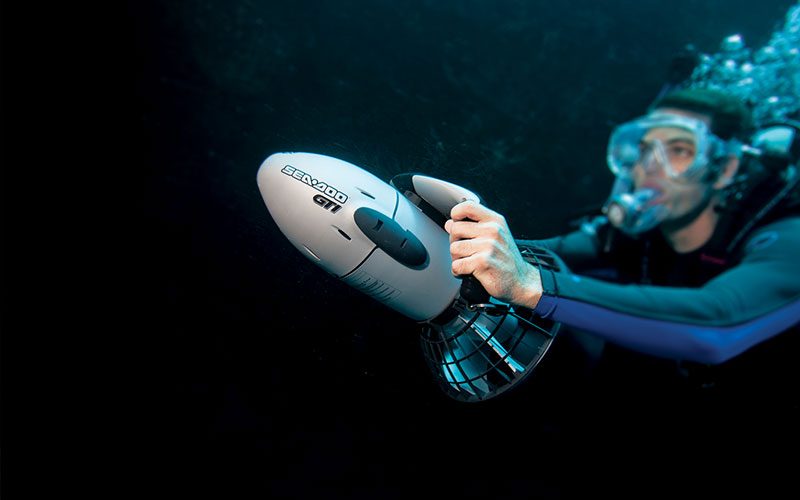There is hardly anything that can compare with taking that first breath of compressed air underwater. It’s totally unnatural — contrary to every human survival instinct — but the resulting sensation is electrifying. One experience that comes close is the first time one grabs the handles of a diver propulsion vehicle (DPV) and sets off like a fighter jet on an adrenaline-charged flyby of the reef. Effortlessly carving high-speed turns while hugging the contours of the bottom is serious underwater fun. Without a doubt, DPVs redefine diver performance.
DPVs — or scooters, as many divers call them — come in a variety of configurations. The most popular design is the teardrop or torpedo-shaped rig with an aft-mounted propeller and handgrips. The diver squeezes a trigger or triggers to route power to the motor and adjusts his body position to steer the DPV. Alternative configurations include ride-on scooters, back- or tank-mounted models that free up divers’ hands and even foot-mounted DPVs.
Matters of Efficiency

No matter the configuration, the trick to manufacturing a high-performance scooter is to master efficiency at each level of energy conversion. First, the battery must efficiently store chemical energy, and then it must efficiently convert that chemical energy into electrical energy. The control circuitry and motor must then efficiently convert the electrical energy into mechanical motion. Finally, the propeller must efficiently transfer the rotary mechanical motion into propulsive force. If the designer can shave a percentage point or two at each conversion, the overall performance increases significantly.
Unfortunately, improved efficiency and robust design translate directly to dollars, and so in general, the machines that provide higher performance come fully equipped with higher price tags. While an entry-level DPV might cost about $200, more powerful (faster) models and those designed for greater depths can range from $400 to more than $2,000.
One measure of a DPV’s capabilities is its run time — the period the scooter will operate on a full battery charge. This combined with speed, the other primary performance measure, gives users an idea of the distance the DPV can take them. It’s important to consider that over time battery capacity and efficiency can degrade, so a better battery has a higher long-term value. If you’re going to splurge on a particular aspect of a DPV, a better battery is the place to do it.
Battery Technology
Unsurprisingly, battery technology is one of the limiting factors in DPV performance. In this age of tiny gadgets and environmental awareness, scientists and engineers are motivated to constantly push the envelope with regard to battery technology. The more energy they can store in a given weight and volume, the more performance users can extract from battery-powered machines, and that includes everything from cell phones and laptops to automobiles and aircraft.

But high energy-density storage is intrinsically dangerous, and pushing the envelope too far or too fast can lead to unintended consequences. As Boeing recently learned with their 787 Dreamliner, an oversight in battery design can put users on the sidelines rather than in the action. When the planes’ high-tech, high-efficiency lithium-ion batteries started shorting out and causing fires, the Federal Aviation Administration (FAA) promptly grounded the Dreamliners. Despite this recent bad press, lithium-ion batteries offer advantages. They have a high power-to-weight ratio, can charge more quickly and offer more desirable cycling characteristics.
While at least one DPV manufacturer has made the leap to lithium-ion batteries, most use conventional sealed lead-acid batteries, which are fairly reliable but still carry some risk. During the charging process, hydrogen gas is generated as a byproduct, and it can accumulate in explosive concentrations. To counter that issue, a catalytic element is generally added; it combines atmospheric oxygen with the hydrogen before the concentrations reach dangerous levels. However, incidents have occurred in which systems failed and explosions resulted. To avoid such situations, divers must observe proper precautions for maintenance and operation of DPVs.
Performance Points
When comparing DPVs, many aspects of performance should be considered. Start with the overall quality of construction. Depth ratings are a sign of robust design, but pay attention to bearings and seals, as these contribute directly to reliability. Most DPVs have multiple speed settings, which helps conserve battery power and increase utility.
Overall weight and buoyancy are also important. Most DPVs weigh between 20 and 40 pounds, with higher performance models being heavier. Instrumentation such as depth alarms and battery-power meters can help divers maintain a margin of safety in their dive operations. High on the list of desired characteristics should be ease of maintenance, charging time and availability of parts. Also keep an eye out for accessories such as lights and variable-buoyancy systems.
The Training Trap

One of the keys to safe scooter diving is proper training. It might be tempting to think that little real training is actually needed — that operation is simply a matter of point, pull and party. In reality, a DPV adds a whole new set of potential risks to diving activities. First among these is the potential for rapid ascents and descents, with the attendant risks of decompression illness and barotraumas. It can be difficult to make needed buoyancy adjustments while scootering, and so unintended separation from the DPV could leave a diver in a seriously over- or under-buoyant condition, leading to excursions to unintended depths. Furthermore, because DPVs allow divers to travel so much farther in the brief timespan of a dive, a mechanical failure or human error could leave a diver stranded far from the planned exit point. This is a particularly significant consideration for cave divers.
Among the challenges that come with DPVs is maintaining buddy contact between divers (zipping around doing barrel rolls can be absorbing), so resist the tendency to get separated. There are also the aforementioned hazards associated with routine maintenance (i.e., battery charging), which means established protocols must be followed to minimize the risk of explosion. So before you grab the horns and wrestle the aquatic mechanical bull into the bay, take some specialty training to get a handle on the basics of safe operation and maintenance.
Diver propulsion vehicles can seriously redefine fun and performance in our underwater world, but with heightened performance comes heightened risks. With the right knowledge and training, we can sidestep the risks and enjoy the ride.
© Alert Diver — Q2 Spring 2013